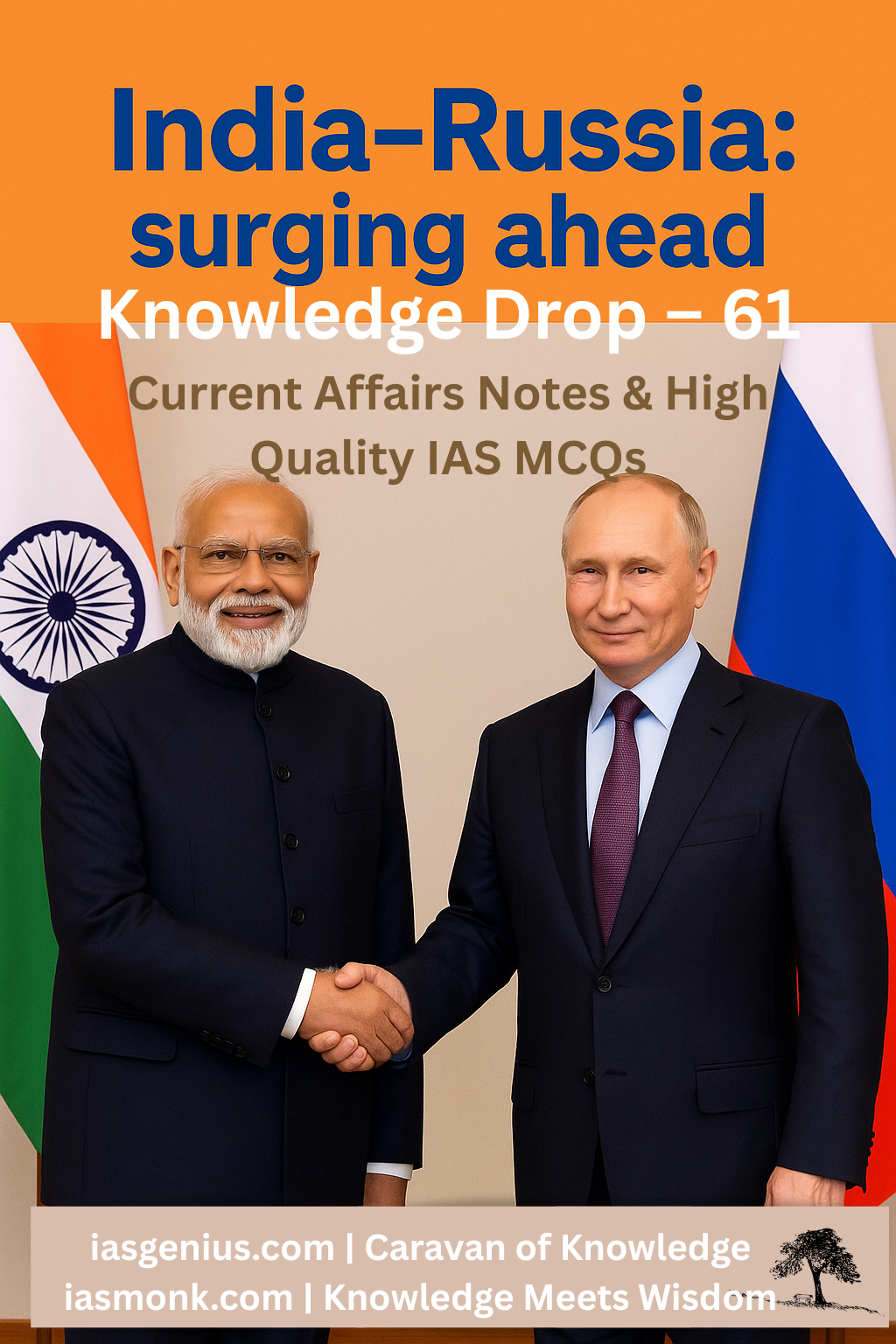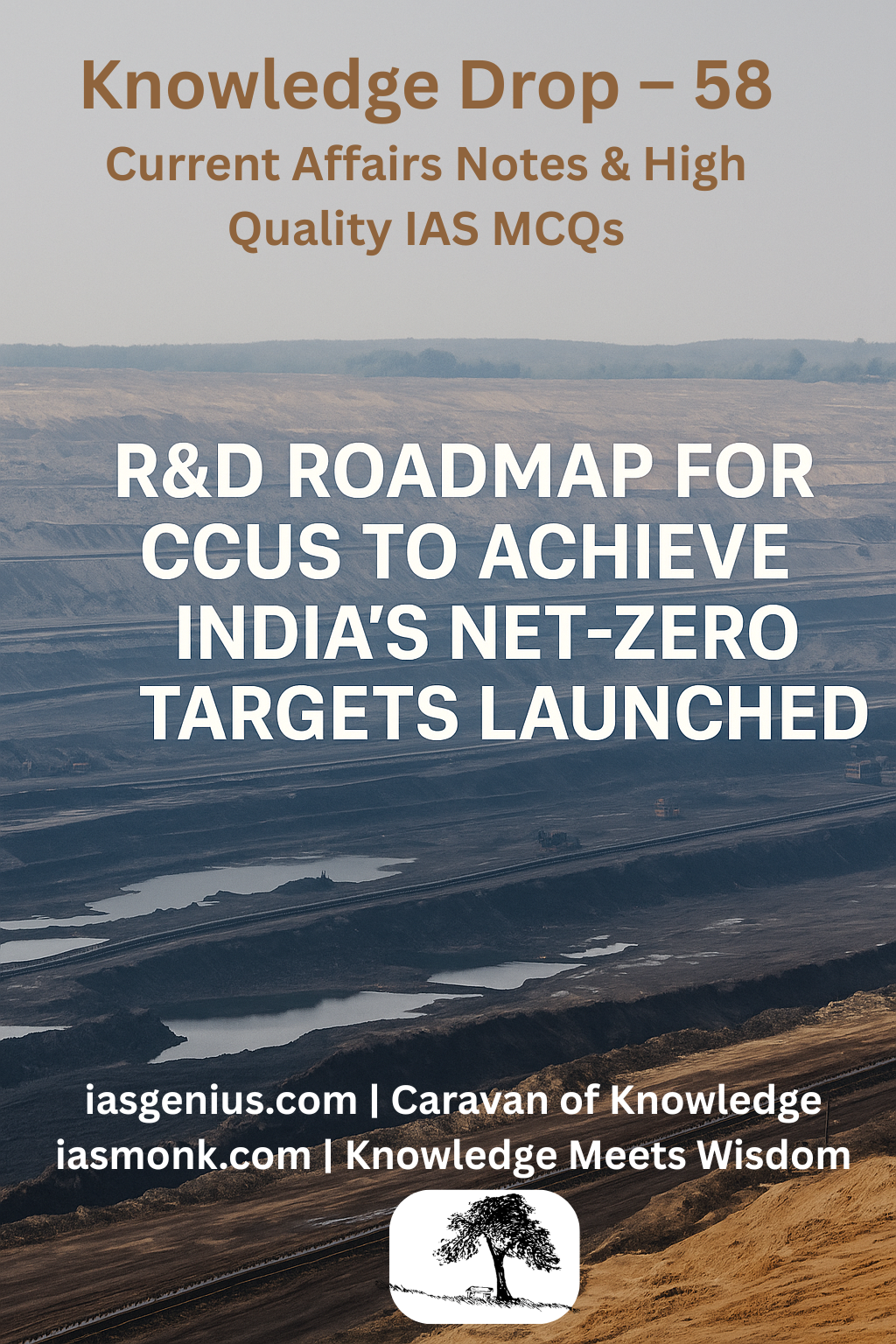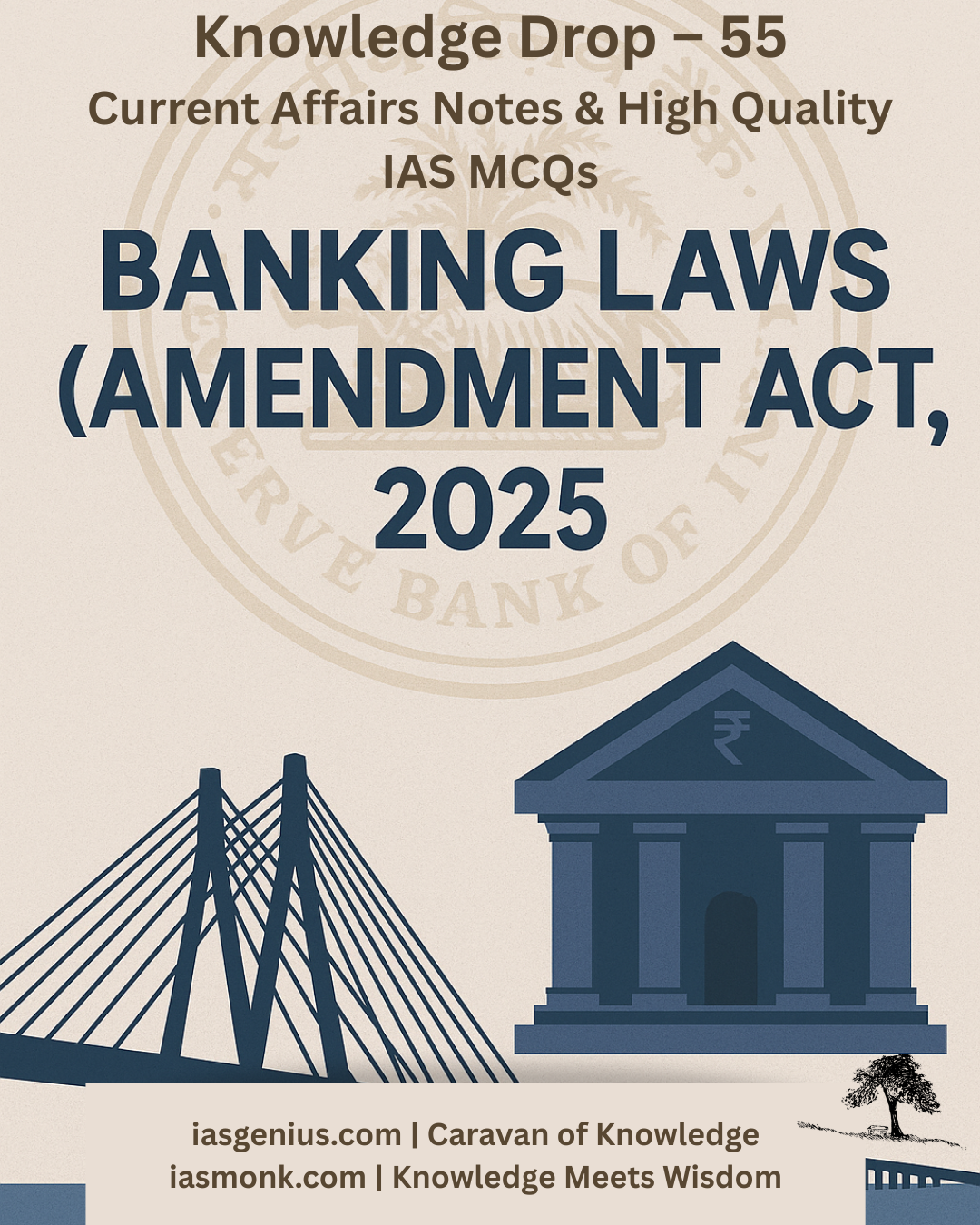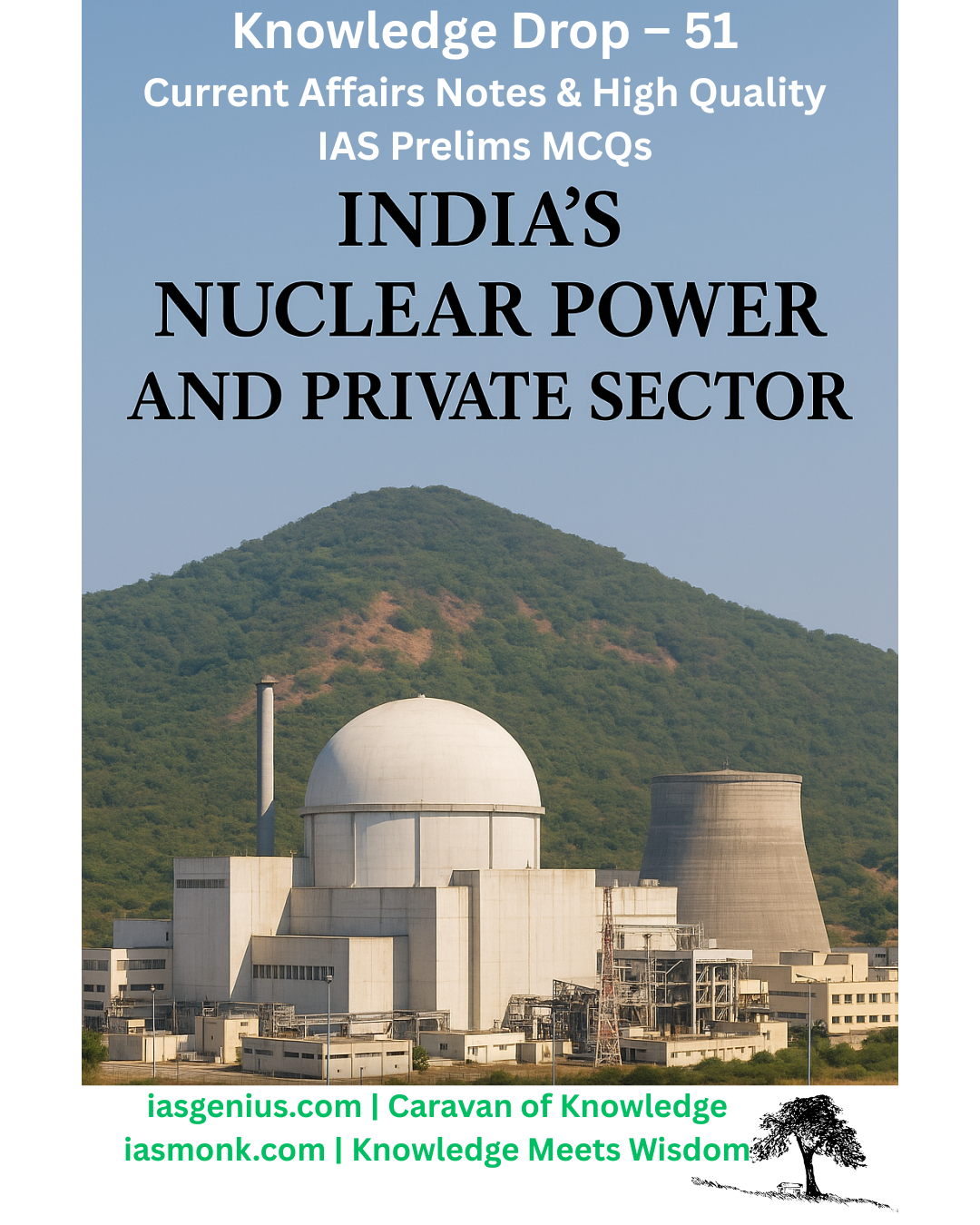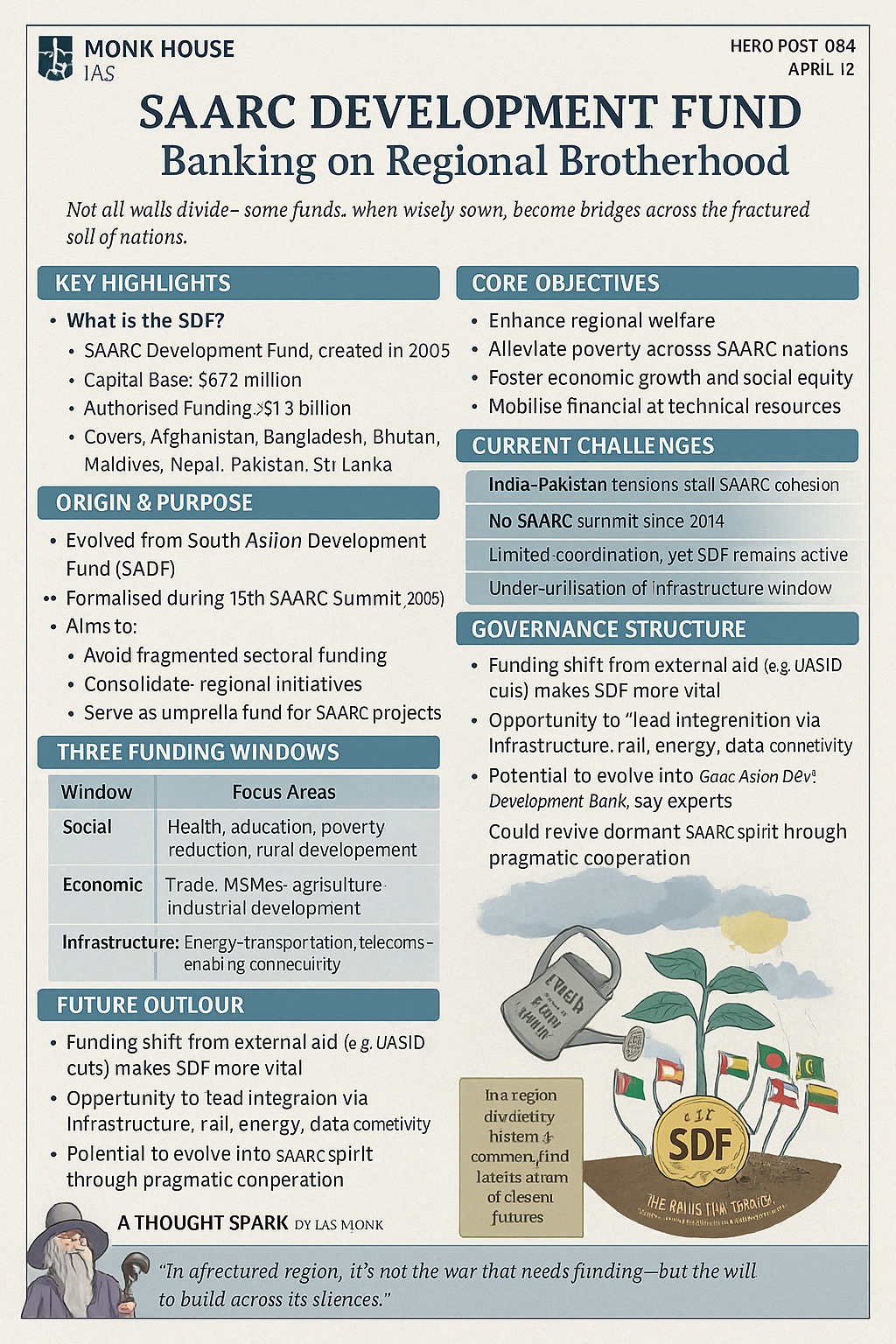
📅 May 5, 2025, Post 2: 🌞Sowing the Sun: Agriphotovoltaics and India’s Solar-Agriculture Future | Mains Essay Attached | Target IAS-26 MCQs Attached: A complete Package, Dear Aspirants!
🌞Sowing the Sun: Agriphotovoltaics and India’s Solar-Agriculture Future

NATIONAL HERO — PETAL 002
🗓️ May 5, 2025
Thematic Focus: Renewable Energy ☀️ | Agriculture 🌾 | Innovation
🌞 Opening Whisper
What if the same sun that ripens the grain could also power the home that stores it?
Key Highlights
• Agriphotovoltaics (APVs) blend solar energy generation with crop cultivation by elevating solar panels over farmland — a model of dual-use land.
• The concept was first introduced in 1981 by German scientists Adolf Goetzberger and Armin Zastrow.
• How It Works: Solar panels are installed above crops at a height that permits light penetration and movement of farm machinery. This creates a microclimate that reduces water loss and shields plants from heat stress.
• Revenue Benefits:
🔹 Farmers can earn from both crop yields and selling surplus solar power back to the grid at fixed feed-in tariffs.
🔹 Example: In Najafgarh, Delhi, farmers leasing land for APVs earned ₹1 lakh/acre/year, and by cultivating shade-loving crops like turmeric and tomatoes, they could earn up to ₹1.5 lakh/acre — a 6x boost over traditional farming.
☀️ Solar Energy in India: Key Achievements
– 100 GW Solar Capacity Milestone:
India’s solar power grew 3450% in just a decade — from 2.82 GW in 2014 to 100.33 GW as of January 31, 2025.
– Record-Breaking Year (2024):
🔹 India added 24.5 GW of solar capacity — more than double that of 2023.
🔹 Utility-scale solar surged 2.8x, hitting 18.5 GW in 2024 alone.
Scaling Agriphotovoltaics in India
• Policy Push Required:
🔹 India lacks a formal Agrivoltaics Policy, but PM-KUSUM can be revised to integrate APVs.
🔹 Financial incentives, credit guarantees, and targeted subsidies are essential for widespread adoption among smallholder farmers.
• Feed-in Tariffs (FiTs):
🔹 Enhancing tariffs for solar power from agricultural land can make APVs financially attractive.
• Skill & Infrastructure Development:
🔹 Farmers need technical training in APV operations.
🔹 Public-private partnerships, adaptive R&D, and climate-specific designs will ensure scalability.
• At present, APVs remain confined to pilot projects. Their future lies in policy integration, awareness drives, and investment accessibility.
🧭 GS Paper Mapping
• GS Paper 3 – Energy & Technology, Agriculture
🔹 Solar Energy, PM-KUSUM Scheme
🔹 Land-Use Efficiency and Innovation
🔹 Climate Resilient Agriculture
🔹 Public-Private Partnerships
• GS Paper 2 – Government Schemes & Policies
🔹 Role of State and Central Support in Renewable Energy Integration
🔹 Welfare of Small and Marginal Farmers
💭 A Thought Spark — by IAS Monk
A single acre can now harvest both sunlight and sustenance. When policy, science, and soil work together, the sun no longer sets on the farmer’s fortune.
High Quality Mains Essay For Practice :
Word Limit 1000-1200
India and the Solar Renaissance: Marching Toward Renewable Superpowerdom
The 21st century belongs to energy. But not just any energy — renewable, decentralized, inclusive energy. As the planet stares down the barrels of climate crisis, energy transition is no longer a choice but an imperative. Among renewables, solar energy stands out — abundant, scalable, clean, and empowering. For India, a nation basking in over 300 sunny days a year, solar energy is not just an environmental solution — it is a civilizational opportunity. The question is no longer whether India can become a renewable superpower — but how soon, and how wisely.
I. The Solar Tapestry of India: A Glimpse of Radiant Growth
India’s tryst with solar energy is recent but remarkable. From a modest 2.8 GW of solar capacity in 2014, the country crossed the 100 GW milestone in January 2025, marking a 3450% growth in a decade. In 2024 alone, India added a record 24.5 GW, of which 18.5 GW came from utility-scale solar — more than doubling its previous year’s tally.
Flagship schemes such as PM-KUSUM, Rooftop Solar Initiative, and Solar Parks Scheme have driven expansion across sectors. Simultaneously, state-specific policies, green energy corridors, and solar tendering by SECI have created an ecosystem of public-private participation.
This growth is not just statistical; it is strategic. Solar energy is now cheaper than coal in many states. It reduces import dependence, boosts local jobs, and supports climate commitments. It is the backbone of India’s Nationally Determined Contributions (NDCs) under the Paris Agreement and the beating heart of its Energy Independence Mission by 2047.
II. Why Solar Energy Suits India Perfectly
India is uniquely placed to lead the solar world. Its geographical advantages, demographic dividend, and policy clarity make it a natural champion.
- Solar Geography: India receives 4-7 kWh/m²/day of solar irradiation — among the highest in the world. This allows both centralised (solar parks) and decentralised (rooftop, agrivoltaics) models.
- Agrarian Integration: Solar energy can be coupled with agriculture — through agriphotovoltaics, solar pumps, and solar fencing — making energy a friend of the farmer.
- Demographic Leverage: A young, tech-savvy population ensures scalability of solar workforce — from manufacturing to maintenance.
- Decentralisation Possibility: Solar energy aligns with India’s federal structure. States can chart their own solar policies, and even remote villages can leapfrog into solar microgrids.
- Political Will: India’s ambitious target of 500 GW of non-fossil fuel capacity by 2030 and global leadership in the International Solar Alliance (ISA) underscore strong commitment.
III. Global Solar Politics: India at the Helm
In a renewable-centric world order, energy leadership is shifting from petro-states to electro-states. Solar-rich, tech-capable nations will hold influence not just economically but geopolitically. India has already made headway:
- International Solar Alliance (ISA): Co-founded by India and France, the ISA now has over 120 member countries, helping solarise the Global South.
- One Sun One World One Grid (OSOWOG): India envisions a global grid that transmits solar energy across time zones, connecting continents and stabilising supply.
- G20 and COP Leadership: India has mainstreamed solar into climate diplomacy, linking it with finance, adaptation, and equity.
These moves position India as not just a producer of solar power — but a moral and technological leader in global energy transition.
IV. Challenges Along the Solar Path
Despite this promise, India’s journey to solar supremacy is not without hurdles:
- Storage and Intermittency: Solar is variable. Without energy storage solutions (batteries, pumped hydro), grid stability suffers.
- Land Conflicts: Large-scale solar parks may compete with agriculture or forests, unless balanced by agrivoltaics and wasteland utilisation.
- Supply Chain Dependence: India still imports most of its solar modules and wafers from China. Self-reliance in solar manufacturing is crucial.
- Financing and Affordability: Small and marginal farmers, rooftop owners, or MSMEs lack access to cheap finance for solar adoption.
- Grid Integration and Infrastructure: Many regions lack grid strength to absorb large-scale solar inflow.
- Recycling and Waste: Solar panels have a lifespan of 20–25 years. India must prepare now for solar e-waste management.
V. Pathways to Becoming a Solar Superpower
India’s ambition to be a renewable superpower can be realised through a strategic, inclusive, and visionary roadmap:
- Atmanirbhar Solar Manufacturing: Expand PLI schemes for solar modules, cells, and wafers. Build semiconductor ecosystem.
- R&D for Storage & Innovation: Invest in battery technology, green hydrogen, and perovskite solar cells.
- Agrivoltaics Revolution: Combine solar and farming across India’s 140 million hectares of cultivable land.
- Rooftop Renaissance: Unlock urban solar potential through net metering, subsidies, and simplified approvals.
- Green Jobs & Skilling: Create 1 million+ solar jobs in installation, maintenance, and research by 2030.
- Energy Justice: Ensure equitable access to solar — in tribal villages, island communities, and urban slums.
- Exporting Solar Diplomacy: Supply clean power, tech, and training to Africa, Southeast Asia, and island nations — making India a solar capital of the Global South.
VI. The Ethical and Civilizational Case
Solar energy is not just about photons — it is about freedom. Freedom from fossil dependence. Freedom from pollution. Freedom for communities to generate their own power, own their transitions, and rise with dignity.
It also resonates with India’s ancient reverence for the sun — from Vedic hymns to Surya Namaskar. The sun has always been seen not just as a source of light, but as a giver of life and rhythm. Now, modern India must let this light power its economy, ecology, and ethos.
Conclusion: Sunrise Nation on a Solar Horizon
India has the potential to do what few nations can — become energy-rich without becoming environmentally poor. As solar panels bloom on rooftops, farms, lakes, and deserts, they reflect not just light — but hope.
India’s path to becoming a superpower in the renewable world lies not in outshining others, but in illuminating pathways — of sustainability, equity, and innovation.
The sun rises for everyone — but India, if it stays true to its vision, might be the nation that helps it rise for all.
Quote to End With
“The sun, with all those planets revolving around it and dependent on it, still can ripen a bunch of grapes as if it had nothing else in the universe to do.” — Galileo Galilei
Target IAS-26: Daily MCQs :
📌 Prelims Practice MCQs
Topic:
MCQ 1 – Type 1: How many of the above statements are correct?
Q. Consider the following statements regarding Agriphotovoltaics (APVs):
• 1) Agriphotovoltaics involve mounting solar panels above farmland to enable simultaneous crop cultivation and solar energy generation.
• 2) The concept of APVs was first proposed in the early 2000s by Indian agricultural engineers.
• 3) APVs can reduce water evaporation and protect crops from heat, improving agricultural resilience.
• 4) Farmers can earn revenue from both crop yields and solar energy sold to the grid through feed-in tariffs.
Options:
A) Only two
B) Only three
C) All four
D) Only one
🌀 Didn’t get it? Click here (▸) for the Correct Answer & Explanation
✅ Correct Answer: B) Only three
🧠 Explanation:
• 1) ✅ Correct – Solar panels are elevated to allow farming underneath.
• 2) ❌ Incorrect – APVs were first proposed in 1981 by German scientists Adolf Goetzberger and Armin Zastrow.
• 3) ✅ Correct – APVs create a microclimate that reduces water loss and shields crops from heat.
• 4) ✅ Correct – Feed-in tariffs allow farmers to sell surplus solar energy.
✅ Only 1, 3, and 4 are correct.
MCQ 2 – Type 2: Two Statements Based
Q. Consider the following statements about India’s solar energy progress:
• 1) India added over 24 GW of solar capacity in 2024, the highest ever in a single year.
• 2) India’s solar capacity reached 100.33 GW as of January 2025, up from 2.82 GW in 2014.
Which of the above statements is/are correct?
A) Only 1 is correct
B) Only 2 is correct
C) Both are correct
D) Neither is correct
🌀 Didn’t get it? Click here (▸) for the Correct Answer & Explanation
✅ Correct Answer: C) Both are correct
🧠 Explanation:
• 1) ✅ Correct – 24.5 GW of solar capacity was added in 2024.
• 2) ✅ Correct – Solar energy in India grew 3450%, from 2.82 GW in 2014 to 100.33 GW in Jan 2025.
✅ Both statements are correct.
MCQ 3 – Type 3: Which of the statements is/are correct?
Q. Which of the following statements is/are correct about the policy and scaling needs of Agriphotovoltaics (APVs) in India?
• 1) India currently has a dedicated nationwide agrivoltaics policy.
• 2) PM-KUSUM scheme can be expanded to include APV models.
• 3) Smallholder farmers can benefit from financial incentives and credit guarantees for APV adoption.
• 4) Technical training and capacity-building programs are essential for APV expansion.
Options:
A) 2, 3, and 4 only
B) 1 and 2 only
C) All four
D) 1 and 3 only
🌀 Didn’t get it? Click here (▸) for the Correct Answer & Explanation
✅ Correct Answer: A) 2, 3, and 4 only
🧠 Explanation:
• 1) ❌ Incorrect – India currently lacks a designated agrivoltaics policy.
• 2) ✅ Correct – PM-KUSUM can be revised to incorporate APVs.
• 3) ✅ Correct – Credit support and subsidies are essential for small farmers.
• 4) ✅ Correct – Capacity-building is a must for successful implementation.
✅ Only 2, 3, and 4 are correct.
MCQ 4 – Type 4: Direct Fact
Q. Who first proposed the concept of Agriphotovoltaics (APVs)?
A) Sunder Lal Bahuguna and Vandana Shiva
B) Adolf Goetzberger and Armin Zastrow
C) Verghese Kurien and M.S. Swaminathan
D) Elon Musk and Andrew Blakers
🌀 Didn’t get it? Click here (▸) for the Correct Answer & Explanation.
✅ Correct Answer: B) Adolf Goetzberger and Armin Zastrow
🧠 Explanation:
• • The idea of agrivoltaics was first proposed in 1981 by German scientists Adolf Goetzberger and Armin Zastrow.

